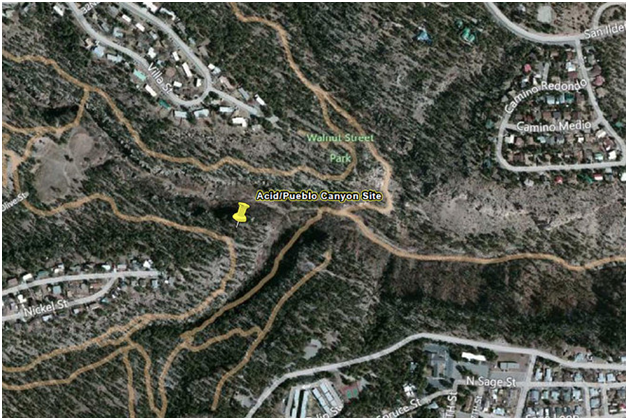One of the things that bothers me the most when I write about nuclear affairs is the fact that all over the world there are areas where due to accidents, deliberate dumping or nuclear tests there are heighten levels of radiation. Metastudies have shown that, although there are natural radioactive materials that generate a low level of "background" radiation everywhere, there is no real "safe" level of radiation for human beings. Any nuclear radiation from any source will increase the incidents of birth defects, cancers and other diseases.
Near Los Alamos, New Mexico, there is a major nuclear research center called the Los Alamos National Laboratory (LANL). The Laboratory was one of the two principle facilities where the U.S. developed nuclear weapons. Near the Laboratory, there is a small canyon called Acid Canyon. During the Manhattan Project, the canyon was use as a dump for pipes, culverts and other debris by local residents and the staff of the LANL. A chemical waste treatment plant was located near the canyon and between 1943 and 1964, more than thirty million gallons of treated and untreated radioactive and chemical waste was flushed into Acid Canyon. The waste included tritium, strontium, plutonium and other radioactive substances that coated the rocks and soaked into the soil of the canyon. Children of the LANL staff played in the canyon in the 50s and 60s.
There have been three cleanups of Acid Canyon over the past forty years. There are still radioactive particles in the soil but the monitors from the Laboratory say that the radiation levels are under the national health standards. No one is sure exactly what remains and construction and repair crews sometimes find old waste drums when they dig in the area.
There are over two thousand dumpsites on the LANL forty three square-miles property. There thousands of other dumpsites at a hundred and eight sites around the U.S. where waste from the Manhattan Project and subsequent nuclear weapons programs was dumped with little regard for environmental or health threats. People working at or living near Cold War nuclear weapons facilities were exposed to a lot of nuclear radiation. People have requested compensation from the federal government for a variety of illnesses including cancers that they say were cause by their work on nuclear weapons. Over a hundred thousand nuclear workers have received almost twelve billion dollars in compensation and medical coverage.
Unfortunately, nuclear waste is exempt from many federal environmental laws including the Clean Water Act. The state of New Mexico has been granted some control over hazardous waste from LANL by the courts. In 2014, LANL was working on the removal of about four thousand cubic meters of hazardous and radioactive waste. The waste is being shipped to the WIPP near Carlsbad, New Mexico. Some of the waste was mixed with the wrong absorbent material and a drum sent to WIPP exploded, releasing radioactive contamination into the environment. There are hundreds of drums of LANL waste that may be at risk for exploding. There are still thousands of cubic meters of waste at LANL in an area that is above a regional aquifer.
Decades and billons of dollars have been spent trying to clean up this Cold War legacy but the work is not finished and it may never be completed at some sites. There are millions of cubic feet of nuclear waste than needs to be cleaned up and hundreds of contaminated buildings that have been or need to be demolished. The banks of the Savannah River in South Carolina and the Hanford Nuclear Reservation in Washington State are two major sites of nuclear pollution but there are a dozen more sites that have very serious contamination. These site pose a long-term threat to human health. The U.S. spends hundreds of billions of dollars on defense. More of that money should be spent on cleaning up the nuclear legacy of the Cold War.
